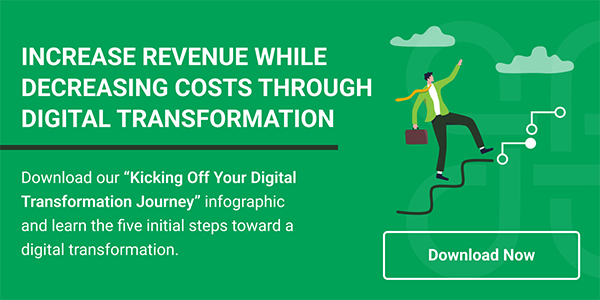Every company that wants to remain competitive and drive growth must improve efficiencies and reduce costs. These are fundamental goals that can come to fruition when organizations pursue and achieve digital transformation. Many industries have discovered that automation is a great solution to achieve their goals. As a result, robotic process automation (RPA) use is rapidly expanding as organizations realize its value in driving digital transformation.
Here, we’ll investigate digital transformation, RPA, the relationship between the two, and why they are connected.
What Is Digital Transformation?
Defining digital transformation is complicated. It’s different for every business. In simple terms, it’s the adoption of technology, processes, and methodologies to drive change and meet efficiency, value, and innovation goals.
Overall, the primary objective of digital transformation is to create new business processes or modify existing ones. It has many moving pieces and transcends roles and departments; it’s an enterprise-wide initiative. A successful transformation can streamline workflows, improve worker productivity, enhance customer experiences, and support growth.
Digital transformation can drive so many operational and competitive advantages—but why is it so essential to business success?
Digital Transformation Drives Change for Modern Businesses
Many modern business challenges can be solved with digital transformation. From addressing labor shortages to enabling hybrid work to cut costs related to legacy systems and processes, digital transformation and the adoption of technology can make a big difference.
Companies are even more keenly aware of their gaps and issues since the pandemic exposed many of them. This awareness led to an acceleration of digital transformation strategies. Businesses now have even more incentive to venture along this complex, multifaceted path. One of the most accessible ways to jump-start the journey is with RPA.
What Is Robotic Process Automation?
Robotic process automation is a system of “digital workers” that can assume repetitive, rules-based tasks. Organizations can scale RPA across their enterprise. They can build, deploy, and manage these “software robots” to emulate human actions such as keystrokes, navigation, and identification and extraction of data.
Why Do Companies Use RPA?
Organizations leverage RPA to achieve lots of things, including:
- Streamlining workflows (RPA robots can complete many tasks 4 to 5 times faster than their human counterparts)
- Freeing up employees to do more high-level work so they can improve their skill sets and be more productive and satisfied
- Reducing errors
- Saving money
- Ensuring compliance
RPA is also vital to accelerating transformation, with 63 percent of executives stating it’s a major component of their overall transformation.
RPA and Digital Transformation: A Symbiotic Relationship.
The connection between RPA and digital transformation is, on the one hand, simple: the former is a critical tool to facilitate the latter. On the other hand, they are interdependent or symbiotic and need each other to thrive.
Unfortunately, it’s not as easy as deploying some bots into your platforms. A lot of RPA projects that companies begin in pursuit of transformation falter. The reason for failure is often misalignment of vision, intent, expected outcomes, or a lack of full understanding of the processes they designate to automate.
Many organizations struggle with deployment as well. Over half (52 percent) of those asked in a survey agreed the implementation was difficult.
These challenges exist, but they aren’t unbreakable barriers. Rather, RPA backed by an appropriate strategy can be highly effective in digital transformation and can even exceed expectations. When deployed with the right partner and plan, you can see improvements in the back, middle, and front offices.
How RPA Aligns with Digital Transformation Plans
RPA is deterministic in nature because you know the expected outcome of the process. These are transactional and standardized processes you’re automating to drive efficiency. Digital transformation is a bit more abstract in that there are many potential paths toward accomplishing it.
Whatever path you choose, RPA needs to be on it. Its incorporation into your transformation plans should include:
- Aligning RPA capabilities with your strategic transformation goals
- Establishing governance of RPA as you scale it across the company
- Ensuring you’re deploying RPA in a stable environment
- Defining success metrics to understand RPA’s impact on digital transformation
How RPA Supports Digital Transformation
RPA makes an impact on the digital transformation journey in many ways. It helps evolve operational challenges. It can work within any system, from enterprise ERPs to legacy systems to accounting platforms. RPA also takes the burden off your people in back-office processes. It trims the waste from bloated processes, improving business performance across the company.
And with its big data analytical capabilities, achievable when you combine RPA and AI, you can derive insights and knowledge. You can learn more about the next level of automation by reading “Digital Transformation and Artificial Intelligence: A Look Into the Future.”
To learn more about digital transformation, RPA, and how they work together, download our infographic, “Kicking Off Your Digital Transformation Journey.”



